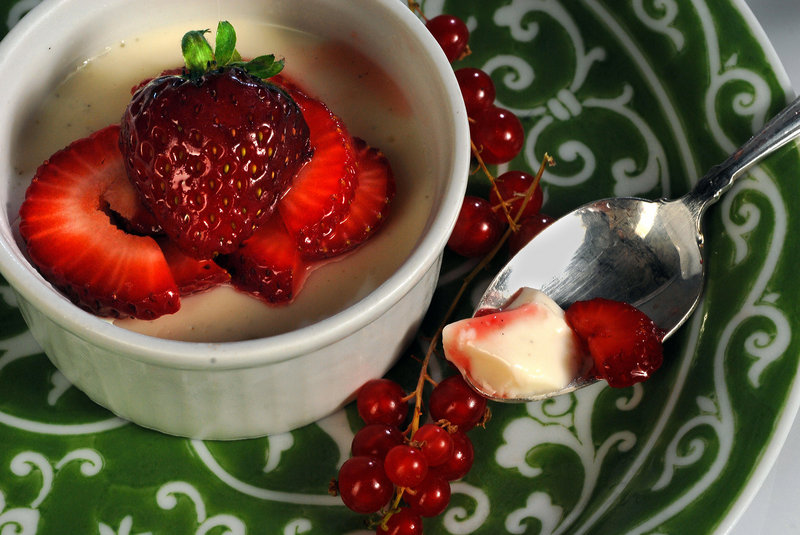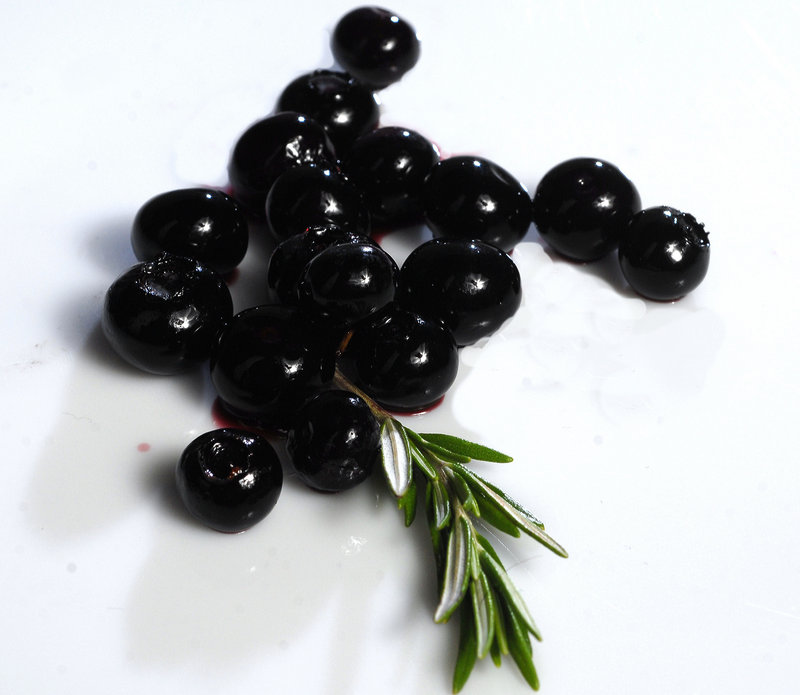Cool and elegant, panna cotta is the little white dress of summer, ready to be dressed up or down, depending on your mood.
The creamy custard recently has popped up on so many swanky menus, diners may be forgiven for thinking it’s a new, trendy thing. Panna cotta, which means “cooked cream,” is a classic Italian dessert. Or it is in its traditional form.
These days, chefs are taking the pale custard to new heights. At San Francisco’s Credo, for example, they infuse the cream with fresh rosemary and top it with pickled blueberries. At Saint Michaels in Palo Alto, Calif., it’s blended with Meyer lemons and blackberries. And at Absinthe in San Francisco, Bill Corbett is doing a buttermilk version with roasted strawberries and basil meringue.
Home cooks may not go to quite those lengths, but there’s no denying the dinner party appeal of a dish that can be made the night before and adapted to fit any taste or occasion.
At its most basic, panna cotta is a milky blend – of buttermilk and cream, for example, or goat milk – that gets its set from gelatin. There are no eggs, and flavorings are minimal, so the flavors are clean and light. And unlike its baked cousins, flan and creme brulee, this custard thickens in the refrigerator while the chef walks away, cool as a cucumber.
Last winter, sous chef Kate Kiernoziak began infusing panna cotta with fresh herbs at Credo, starting with sage and lemon, when the fruit pickings were slim. In August, bringing in seasonal notes is a breeze.
“I wanted to do something that was a little bit unique, and I began noticing a lot of herb usage in desserts,” she says. “The one I’ve just started playing with is rosemary panna cotta with pickled blueberries. I’m Eastern European in background, so I pickle a lot of things and find ways to incorporate them in sweet dishes. There’s a little essence of rosemary, a hint in the blueberries, too.”
Despite the cream at its base, panna cotta strikes a delightfully light note, which Kiernoziak says is appreciated by diners and cooks – even neophytes such as Kiernoziak’s sister, who made it for the first time as a Christmas dinner finale.
“It’s not like tiramisu, which feels like you’re eating a bowl of mascarpone cheese and cream,” Kiernoziak says. “And it’s very easy to make, even for an inexperienced cook like my sister.”
The simplicity appeals to Michael Zeiter, the new executive chef at Patrick David’s in Danville, Calif. And, he agrees, it’s nearly fail-safe. There are very few ingredients, no eggs to curdle and no chance of overbaking, because it doesn’t venture anywhere near an oven.
“The beautiful thing is it’s a tasty, creamy base that can be built around anything,” Zeiter says. “That’s part of the joy of it for me. It lends itself to farm-fresh berries and compotes, vanilla beans.
“I’ve got to have those specks of vanilla floating in there.”
Zeiter, whose resume includes stints at New York’s James Beard House, infuses his custard with vanilla bean pods and seeds, then serves the finished panna cotta with fresh berries.
“We handpick the berries – blueberries, raspberries, blackberries, as well as strawberries,” he says. “I cook them down with a little bit of sugar and Prosecco and make a puree, and the fresh berries are dressed with that.”
Patti Dellamonica-Bauler, pastry chef for the Lark Creek group and its many restaurants in San Jose, Calif., Walnut Creek, Calif., and San Francisco, gave the dessert her own twist at Cupola Pizzeria, the newest Lark Creek restaurant at San Francisco’s Westfield Center. When she noticed that the tourist crowd didn’t seem to cotton to cotta with quite the fervor of native diners, she combined two of her favorite dessert concepts by adding one more dairy item to the ingredients list: cream cheese.
“Panna cotta is a vehicle for any kind of milk – coconut milk, soy, buttermilk, yogurt,” she says. “I like creamy cheesecake. This is a way to make a hybrid. It has the undertones of cheesecake.”
At Cupola, the cream cheese panna cotta is topped with a plum compote, a saucy mixture of reduced plums and fresh pluot slices, with a little streusel for crunch. At the non-Cupola restaurants, the chef has been playing with a lemon and blueberry topping, and a last-minute dusting of graham cracker crumbs.
The trick, Dellamonica-Bauler says, is to make these desserts the night before so they can chill and set properly, but wait till the last second to unmold the creamy custard and add the toppings and garnishes of your choice.
Serve it, she says, “freshly dressed.”
GELATIN 101
Leaf gelatin: Professional chefs often use these clear gelatin sheets, which are classified as bronze, silver, etc., depending upon strength. Find them at specialty stores and online at Amazon.com. Leaf gelatin must be softened in water, then drained before using.
Gelatin powder: Most home cooks use powdered gelatin, such as Knox. An envelope – about 1 tablespoon – is the equivalent of four sheets of gelatin. The powder is softened in a small amount of liquid, then both liquid and gelatin are added to the recipe.
Alternatives: Some chefs, including Patrick David’s Michael Zeiter, use carrageenan-kappa, a seaweed extract, to thicken panna cotta. The vegetarian-friendly substance is available at some specialty shops and online at www.lepicerie.com.
ROSEMARY PANNA COTTA WITH PICKLED BLUEBERRIES
Serves 8
Note: At Credo, this panna cotta is served with a drizzled balsamic reduction. Allow three days to pickle the blueberries.
PICKLED BLUEBERRIES:
3 cups red wine
1 cup balsamic vinegar
1 cup sugar
1 sprig rosemary
1 basket or more blueberries
ROSEMARY PANNA COTTA:
6 sheets of gelatin
1 quart heavy cream
¼ cup rosemary, chopped
½ cup sugar
1. Sterilize a 1.5-liter Mason jar and lid in boiling water.
2. Bring vinegar, wine and sugar to a boil. Place blueberries and rosemary in the jar. Pour the hot vinegar mixture into the jar so it completely covers the berries. Seal jar immediately, and let rest three days.
3. Start the panna cotta by soaking the gelatin sheets in cold water.
4. In a saucepan, bring cream and rosemary to a boil; turn off heat. Add sugar.
5. Remove softened gelatin from water, squeeze out excess liquid, then stir into the cream.
6. Pour cream mixture through a strainer, into eight 4-ounce ramekins. Chill overnight, or until set.
7. Serve each panna cotta topped with 8 pickled blueberries and, if you wish, a drizzle of balsamic reduction.
– Kate Kiernoziak, sous chef, Credo restaurant, San Francisco
CREAM CHEESE PANNA COTTA WITH PLUOT SAUCE
Serves 24
Note: “Blooming” the gelatin, i.e., letting it soak for 3-5 minutes, helps ensure a smooth final result.
6 cups half-and-half
6 cups cream
½ teaspoon salt
2½ teaspoons green cardamom pods, toasted and crushed
16 grams rosemary, stemmed and bruised
16 gelatin sheets, bronze, bloomed in ice water
3¾ cups cream cheese
2 cups superfine sugar
1 tablespoon vanilla bean paste
1 cup pluot sauce (see recipe)
Sliced pluots
1. Heat the half-and-half and cream gently to 150-160 degrees. Add salt, cardamom and rosemary and let the flavors infuse for 30 minutes.
2. Thoroughly drain the gelatin sheets and place them in a large bowl. Warm the cream mixture again and pour through a fine sieve, over the gelatin. Whisk until melted. Set aside to cool.
3. In an electric mixer, beat the cream cheese, sugar and vanilla paste until creamy and smooth.
4. Remove from mixer and whisk in the cooled, infused cream. Pass again through a fine sieve and fill ramekins. Cover with plastic wrap and refrigerate at least 4 hours.
5. When ready to serve, dip ramekins, one at a time, into a bowl of hot water for 3 seconds. Run a thin knife around edge of each ramekin and invert ramekin onto center of a small plate. Garnish each panna cotta with 1 tablespoon pluot sauce and slices of fresh pluot.
PLUOT SAUCE
2½ pounds pluots
1 tablespoon orange juice
2 tablespoons sugar
¼ teaspoon vanilla
1. Slice three pluots into slim wedges, 12 each.
2. Peel and chop the remaining pluots. Add the juice, sugar and vanilla, and cook in a saucepan over medium heat until syrupy. Let cool, then puree. Stir the pluot slices into the sauce.
– Courtesy of Patti Dellamonica-Bauler, pastry chef, Lark Creek Restaurant Group
PANNA COTTA WITH STRAWBERRIES
Serves 12
1 envelope (1 tablespoon) unflavored gelatin
½ cup milk
4 cups heavy cream
¾ cup sugar
2-inch piece vanilla bean, split lengthwise
3 tablespoons light rum
FRUIT:
4 cups strawberries
¼ cup sugar, or as needed
1. Sprinkle the gelatin over the milk and let stand 5 minutes to soften.
2. Combine the cream and ¾ cup sugar. Using the tip of a sharp knife, scrape the vanilla seeds into the cream, then add the pod. Place over medium heat; stir until the cream just starts to simmer. Off heat, add gelatin mixture; stir to dissolve completely. Cool 10 minutes.
3. Remove vanilla pod. Stir in rum. Divide mixture among ½-cup ramekins. Cover with plastic wrap; chill until set, about 8 hours.
4. About an hour before serving, combine half the berries with ¼-cup sugar, and crush with a fork. Slice remaining strawberries and add to the bowl. Toss to combine. Taste and add sugar, if needed. Cover and chill until serving.
5. To unmold, set each ramekin in enough warm water to reach halfway up the sides. Let stand 20 seconds. Remove from water, wipe dry, then place a serving plate on top and invert. Shake gently until the custard comes loose. (You may need to run a small knife around the inside edge of the cup to loosen.) Spoon berries around the creams and serve.
– Chuck Williams and Kristine Kidd, “Williams-Sonoma Cooking at Home” (Weldon Owen, 640 pages, $34.95)
Send questions/comments to the editors.




Success. Please wait for the page to reload. If the page does not reload within 5 seconds, please refresh the page.
Enter your email and password to access comments.
Hi, to comment on stories you must . This profile is in addition to your subscription and website login.
Already have a commenting profile? .
Invalid username/password.
Please check your email to confirm and complete your registration.
Only subscribers are eligible to post comments. Please subscribe or login first for digital access. Here’s why.
Use the form below to reset your password. When you've submitted your account email, we will send an email with a reset code.